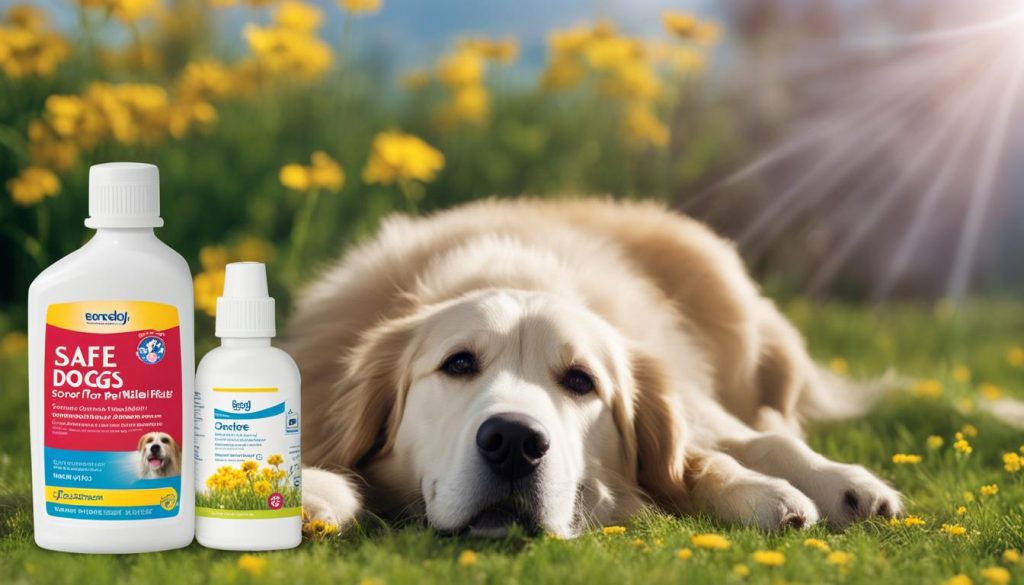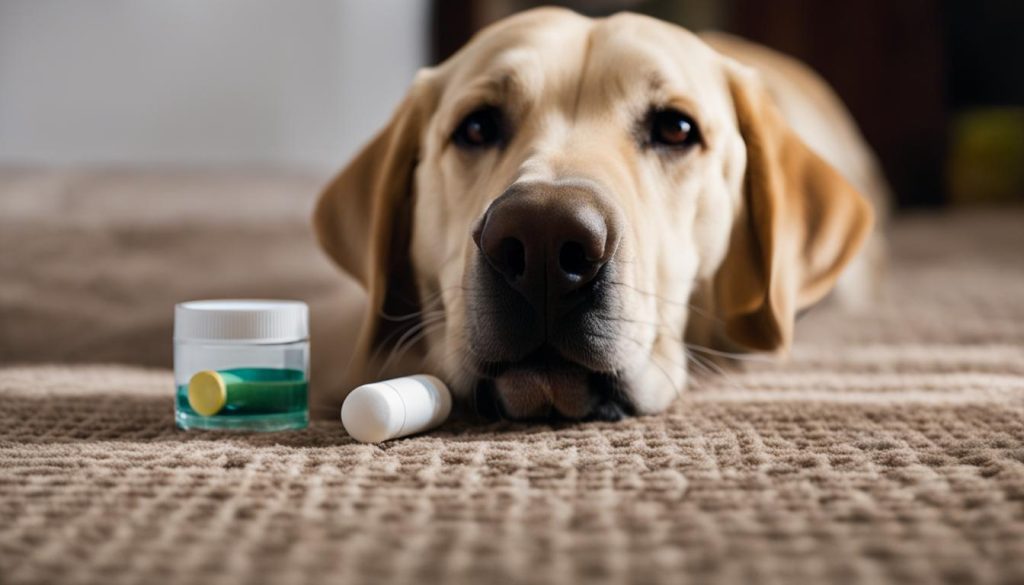Hi there! Are you wondering if it’s safe to give your furry friend Benadryl? Well, I’m here to help you navigate through this common concern. Let’s dive in and explore whether Benadryl is suitable for dogs and how it can help with allergic reactions.
As a pet parent, you want the best for your canine companion. That’s why it’s essential to seek professional advice before administering any medication to your dog. In this article, we’ll discuss the safe use of Benadryl for dogs and provide you with all the information you need to make an informed decision.
So, can you give a dog Benadryl? Let’s find out!
What Is Benadryl and How Does It Work?
Benadryl is a commonly used antihistamine for dogs, also known as diphenhydramine HCl. It is a first-generation antihistamine that works by blocking the receptors that receive histamines in the body. This helps to relieve symptoms such as itching, sneezing, and hives in dogs.
While Benadryl is not FDA-approved for veterinary use, it is widely used by veterinarians and considered safe for dogs and cats. It is important to note that the dosage and administration of Benadryl should be determined by a veterinarian to ensure it is appropriate for your dog’s specific condition.
Diphenhydramine HCl, the active ingredient in Benadryl, is an antihistamine that helps to counteract the effects of histamine release in the body. Histamines are chemicals that are released during an allergic reaction and are responsible for causing symptoms such as itching, redness, and swelling. By blocking the receptors that receive histamines, Benadryl helps to alleviate these symptoms and provide relief.
How Does Benadryl Work?
When a dog is exposed to an allergen, such as pollen or dust mites, their immune system releases histamines in response. These histamines bind to receptors in various tissues, causing an inflammatory response and the typical symptoms associated with allergies. Benadryl works by blocking these histamine receptors, preventing them from binding with the histamines and reducing the allergic response.
It is important to consult with your veterinarian before giving your dog Benadryl to determine the correct dosage and ensure it is safe for your dog’s specific condition. Your veterinarian will consider factors such as your dog’s weight, overall health, and any other medications they may be taking. They may also recommend additional treatments or strategies to manage your dog’s allergies or symptoms.
What Can Benadryl Treat in Dogs?
Benadryl, a commonly used antihistamine for dogs, can effectively treat various conditions in our furry friends. One of its primary uses is to alleviate allergies in dogs. Dogs can experience allergic reactions to environmental factors like pollen, dust mites, or certain foods. Benadryl helps reduce the itching and inflammation associated with these allergies, providing relief to your pup.
In addition to allergies, Benadryl can also be utilized to ease itching in dogs caused by other factors, such as insect bites or skin irritations. It works by blocking the histamine receptors in their body, reducing the itching sensation and helping them feel more comfortable.
If your dog gets anxious or experiences motion sickness during car rides or travel, Benadryl can be a helpful solution. It has a sedative effect, which can help calm your dog’s nerves and minimize their discomfort while on the move.
Relief for Various Conditions
Overall, Benadryl is a versatile medication that can treat a range of symptoms in dogs. It is beneficial for relieving itching, reducing allergic reactions, managing anxiety and motion sickness, and providing general comfort during discomforting situations.

How to Safely Administer Benadryl to Dogs
Administering Benadryl to dogs requires careful consideration and proper guidance from a veterinarian. Before giving your dog Benadryl, it is crucial to consult with your veterinarian to determine the correct dosage based on your dog’s weight and condition. The recommended dosage typically ranges from 2 to 4 milligrams of Benadryl per kilogram of body weight, given 2 to 3 times a day.
When it comes to the form of Benadryl, liquid Benadryl is often recommended for small dogs, while tablets are more suitable for larger dogs. It is important to note that time-release capsules and any form of Benadryl containing alcohol or sodium should be avoided.
While Benadryl is generally considered safe for dogs, it can have some side effects. Common side effects may include drowsiness, dry mouth, and an increased heart rate. It is essential to monitor your dog closely for any adverse reactions and seek veterinary care if necessary.
Proper Administration Techniques
Here are some tips for safely administering Benadryl to your dog:
- Measure the correct dosage using a syringe or by carefully following the instructions given by your veterinarian.
- If using liquid Benadryl, you can mix it with your dog’s food or offer it directly into their mouth using a syringe.
- If using tablets, you can hide them in a treat or wrap them in a small piece of cheese to make them more appealing to your dog.
- Always observe your dog after administering Benadryl to ensure they swallow it and don’t spit it out.
- If you have any concerns or questions about administering Benadryl to your dog, it is best to consult with your veterinarian for guidance.
Remember, while Benadryl can be a useful medication for managing allergies, itching, motion sickness, and other symptoms in dogs, it is crucial to consult with your veterinarian before giving any medication to your dog. Your veterinarian can provide the appropriate guidance and ensure the safety and well-being of your furry friend.

Conclusion – Is Benadryl Safe for Dogs?
After careful consideration, it is clear that Benadryl can be a safe and effective medication for dogs when used correctly and with guidance from a veterinarian. It can provide relief for various conditions such as allergies, itching, motion sickness, and anxiety. However, it is crucial to consult with a veterinarian before giving Benadryl to your dog to ensure the correct dosage and suitability for your dog’s specific needs.
Your veterinarian is the best source of information when it comes to your dog’s health, and they can help determine the appropriate dosage based on your dog’s weight and condition. By working closely with your veterinarian, you can ensure the safe and responsible use of Benadryl for your furry friend.
Remember, each dog is unique, and what works for one dog may not work for another. Consulting with a veterinarian will help you make informed decisions and avoid any potential risks or side effects. Your dog’s well-being is a top priority, so don’t hesitate to reach out to your veterinarian and consult them before administering any medication to your beloved pet.
FAQ
Can I give my dog Benadryl?
Yes, Benadryl is commonly used and prescribed by veterinarians to treat allergies, travel anxiety, motion sickness, and other symptoms in dogs. However, it is important to consult with your veterinarian before giving your dog Benadryl to determine the correct dosage and ensure it is appropriate for your dog’s specific condition.
What is Benadryl and how does it work?
Benadryl, also known as diphenhydramine, is a first-generation antihistamine that works by blocking the receptors that receive histamines in the body. This helps relieve symptoms such as itching, sneezing, and hives.
What can Benadryl treat in dogs?
Benadryl can be used to treat a variety of conditions in dogs, including allergies (itching, hives, swelling, redness, runny nose, and eyes), motion sickness, and anxiety. It may also be prescribed for dogs with mast cell tumors or during heartworm treatment to manage symptoms and reduce the risk of allergic reactions.
How do I safely administer Benadryl to my dog?
It is important to consult with your veterinarian to determine the correct dosage of Benadryl for your dog based on their weight and condition. The recommended dosage is usually 2-4 milligrams of Benadryl per kilogram of body weight, given 2-3 times a day. Liquid Benadryl is recommended for small dogs, while tablets are often used for larger dogs. Avoid time-release capsules and any form of Benadryl that contains alcohol or sodium. Monitor your dog for any adverse reactions and seek veterinary care if necessary.
Is Benadryl safe for dogs?
Benadryl is generally considered safe for dogs when used correctly and under the guidance of a veterinarian. However, it is always important to consult with your veterinarian before giving any medication to your dog to ensure it is safe and appropriate for their specific needs.






